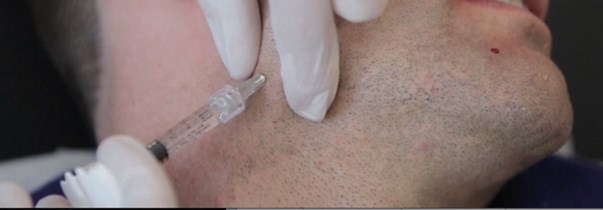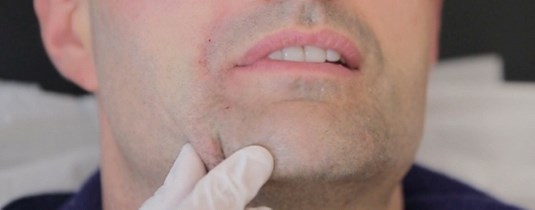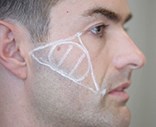Concepts of beauty and attractiveness have always been associated with the appreciation of symmetry, balance and harmony of various facial features. An attractive face creates mystique and power. Its effects are undeniable, and for centuries, we have been trying to measure and enhance faces to meet the standards of beauty dictated by society.
Sexual dimorphism (the phenotypic differences between the sexes) is often less obvious when it comes to facial structure. However, the approach to male aesthetics is different to that of female. In the initial stages of facial development, all human faces begin as essentially feminine, even if genetically male [1]. Through multiple exposures to testosterone during puberty, the male face gradually transforms into the male configuration. Hence it is of utmost importance that we understand sexual dimorphism and have a profound appreciation of male and female beauty. In 2014, Dr Stephen Marquardt developed the male variant of his Phi Mask, which was developed based on the golden ratio [2]. The male version describes the idealised male face and highlights the slight but significant differences between male and female faces. These differences include:
- Prominent supra-orbital ridges (frontal bossing) resulting in deep set appearing eyes.
- Flatter and narrower eyebrow
- Slightly narrower eyes
- 4Heavier eye lids
- Slightly longer and / or wider nose
- Slightly thinner lips (especially upper lip)
- Squarer and / or larger jaws.
Top three areas of the male face to treat with dermal fillers
These days, more men are defying their age by turning to various aesthetic treatments, in search of a fresher version of their visage. From forehead sculpting to chin and jawline augmentation, male clients play an important role in this era of ‘Menaissance’. Here are a few treatments that would help enhance the masculinity of the face; while performing these it is important to remember and to respect the facial proportions.
Angle of jaw
The male jawline is wide and well-defined with a large masseter bulk, giving it a squarer appearance [3,4]. From the frontal view, the angulation of the mandibular ramus is prominent and this should be in line (horizontally) with the corners of the mouth [3,4]. The male face also has a lower gonial angle compared to the female face in the profile view [4]. Most men are blunt at the angle of the jaw, partially due to thinning of the temporal-buccal fat pad. In this area, dermal fillers must be injected supraperiosteally to avoid important structures (e.g. parotid gland and ducts). This treatment will project the jaw laterally and strengthen the jawline, resulting in a square jaw which is desirable in a man.
Step by step guide:
- Pinch the angle of the jaw and lift the tissue with the thumb and index finger of the non-injecting hand.
- Insert needle perpendicularly onto the periosteum.
- Aspirate to ensure that the needle tip is not in a vessel.
- Slowly, inject a bolus of approximately 0.3ml per side.
- Mould the depot accordingly post-injection.
- Further injections should be repeated until the desired result is achieved.

Figure 1: Needle position for angle of jaw treatment.
Chin
In men, the lateral border of the chin should correlate with a vertical line dropped from the corner of the mouth. In the profile view, a line connecting the most prominent portion of the upper and lower lip should touch the pogonion (Riedel line). The lower lip should be 2-3mm posterior to the upper lip and the pogonion should never project beyond this line. We can elongate the chin or enhance its anterior projection with dermal fillers. Increasing the forward projection of the chin will also help tighten the skin around the jawline area. The lateral borders of the chin can also be enhanced, which would result in a squarer chin, as well as adding definition to the jawline.
Step by step guide: enhancing / restoring the borders of the chin
- Identify the area of weakness in the lateral border of the chin by pinching it horizontally.
- Insert needle perpendicularly onto the periosteum, medial to the mandibular retaining ligament.
- Aspirate to ensure that the needle tip is not in a vessel.
- Slowly, inject a bolus of approximately 0.2ml per side.
- Mould the depot accordingly post-injection.
- Repeat until sufficient revolumisation is achieved.
Step by step guide: anterior projection of the chin
- Identify the mid point of the pogonion. For men with a chin cleft requesting anterior projection, fillers should be injected on either side lateral to the cleft in order to preserve it - identify the mid point between the cleft and the lateral border on each side.
- Insert needle perpendicularly onto the periosteum.
- Aspirate to ensure that the needle tip is not in a vessel.
- Slowly, inject a bolus of approximately 0.2ml.
- Mould the depot accordingly post-injection.
- Repeat until sufficient revolumisation is achieved.

Figure 2: Identifying the area of weakness in the lateral border of the chin.

Figure 3: Markings for lateral cheek revolumisation.
Cheeks
Cheek enhancement with dermal fillers is very popular amongst the female clientele in aesthetics. For male patients, however, this is an area that can often go wrong, where too much volume is placed resulting in a more feminine look. The male cheeks are flatter but more angulated when compared to female cheeks [5]. MRI studies have shown that whilst females have 1.5 times thicker subcutaneous fat compartment medially, male patients tend to have a uniform distribution [5,6]. The apex of the cheeks is also lower, more medial and subtly defined [5]. On the skin surface, the male apex can be located at the intersection between the alar-tragal line and a line dropped vertically down from the lateral canthus.
Step by step guide: lateral cheek
- Draw a triangle connecting the lateral canthus, ipsilateral oral commisure and ipsilateral tragus.
- Within the triangle, draw an oval with three points contacting the lines of the triangle tangentially.
- Divide the oval into lateral, middle and medial thirds.
- In the lateral third of the oval, pull the lateral cheek taut along the zygoma – and while maintaining the tissue in taut position, inject a single depot of 0.2ml supraperiosteally using a needle (perpendicular approach).
- Apply pressure on the depot post-injection to distribute it evenly.
- Further injections should be repeated in the middle and medial third of the oval until sufficient revolumisation in the lateral cheek is achieved.
Step by step guide: medial cheek
- Identify the intersection point between the alar-tragal line and a line dropped vertically down from the lateral canthus.
- Insert a 25G cannula medially into the subcutaneous layer and inject the medial cheek in a fan-shaped retrograde manner until sufficient revolumisation is achieved (on average 0.2-0.3ml per side in a male face).
- Filling of the cheek also provides structural support to the tear trough and palpebral malar groove.
Conclusion
In a world where specific concepts of physical beauty in women are ever changing, idealisation of the male face has remained relatively stagnant. This is partially due to the fact that society places more emphasis on female beauty and there are more beauty products on the market targeted to women. However, more men are coming forward in the fight against ageing, resulting in a small but significant portion of the aesthetics clientele – which is predicted to continue growing in the coming years. The goal for male facial aesthetic treatments involves two important aspects: restoration and enhancement. Restoration is a cosmetic intervention to improve a facial area or structure that has changed due to the effects of ageing and the aim is rejuvenation [1]. On the other hand, enhancement is to improve a feature or an area to make the male face more attractive. Hence, the question we need to ask ourselves when analysing a male face is: should we restore or promote a cosmetic enhancement?
References
1. De Maio M, Rzany B. The Male Patient in Aesthetic Medicine. Springer; 2009.
2. Marquardt SR. Dr Stephen R Marquardt on the golden decagon and human facial beauty. Interview by Gottlieb. J Clin Orthod 2002;36(6):339-47.
3. Farhadian JA, Bloom BS, Brauer JA. Male aesthetics: A review of facial anatomy and pertinent clinical implications. Journal of Drugs in Dermatology 2015;14(9):1029-34.
4. Ravichandran E, Ravichandran S. Male vs. Female Facial Rejuvenation. Aesthetics Journal 2015;2(11).
5. Wysong A, Kim D, Joseph T, et al. Quantifying soft tissue loss in the aging male face using magnetic resonance imaging. Dermatologic Surgery 2014;40(7):786-93.
Declaration of competing interests: None declared.
TAKE HOME MESSAGE
-
The aesthetics approach for men is different to that for women.
-
Structural differences of the male face must be respected during any aesthetic procedures.
-
The male cheek must be filled evenly to avoid feminisation of the face.
-
When analysing the male face, consider whether to restore or enhance facial structures.
COMMENTS ARE WELCOME




